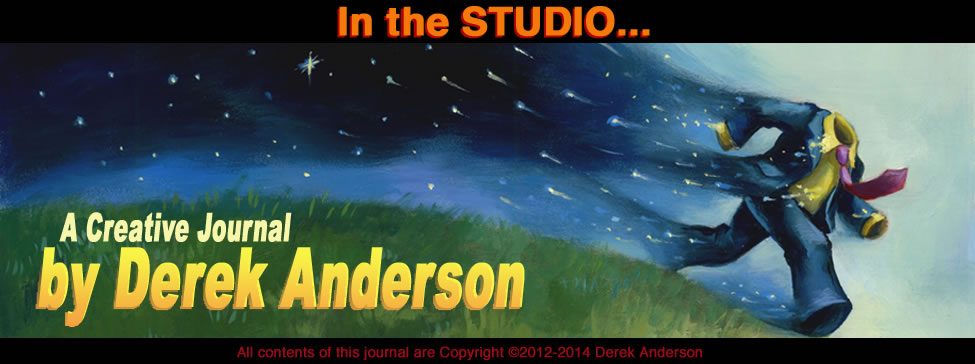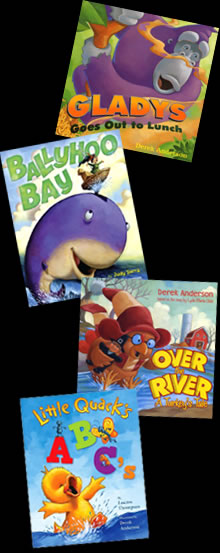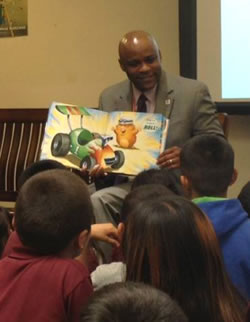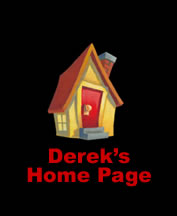Friday, June 7th, 2013

The creator's reading list
As an author and artist, I'm always on the lookout for good books on writing, creating art and creativity. A lot of brave souls have set out to make things and lived to tell their tales. We can learn from them. Here's a short list of some of my favorite books on creating.
Art and Writing
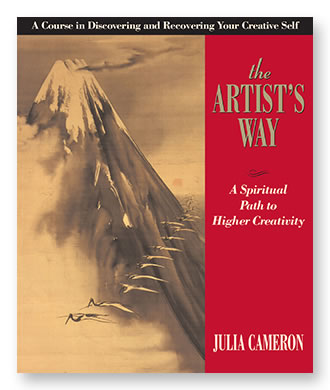
The Artist's Way
by Julia Cameron
A necessary guide for every artist, writer and creative mind that has ever gotten stuck. This book is about pushing past your obstacles. You're not stuck? Read it anyway, it's a fascinating book.
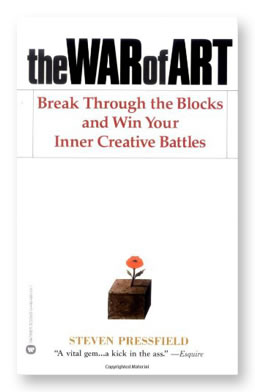
The War of Art
by Steven Pressfield
This is easily one of my favorite books on the subjects of art and creating. Steven Pressfield doesn't mess around. Creating is a war against your own resistance. This is a must read for anyone that's dreamed of creating but keeps coming up with excuses for why they haven't found the right time or place to get started.
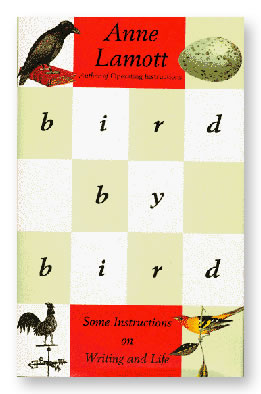
Bird by Bird
by Anne Lamott
Anne Lamott's book should be required reading for every writer, both aspiring and published. The title comes from a story she relates about her older brother who was frantic over a book report he had to write on birds. It was due the next day and he didn't know where to begin. Her father sat down, put his arm around her brother and said, "Bird by bird, buddy. Just take it bird by bird." Great advice and a great book.
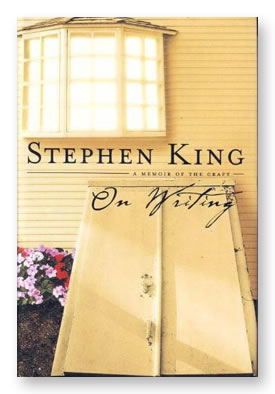
On Writing
by Stephen King
Stephen King is a master storyteller and gives us a rare glimpse into his life and process. You'd better find a comfortable reading chair, you won't be able to put this book down for the entire first half.
Creativity
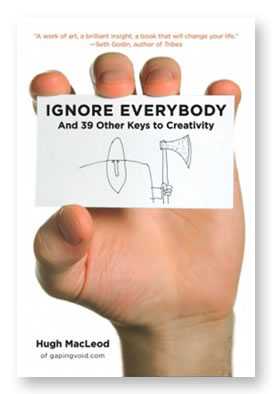
Ignore Everybody
by Hugh MacLeod
Hugh blazed his own trail into the creative world and you should be glad he did. You can learn a lot from this inspiring book. He has a great conversational tone, full of both wit and honesty. There are certain books I won't loan to friends. This is one of them, just in case I want to read it again.

The Creative Habit
by Twyla Tharp
Creativity is widely associated with visual arts, but it's absolutely central to so many professions. Twyla Tharp is a dancer, choreographer and a great creative mind. This is another terrific book on making effective use of creativity, whatever your pursuit might be.
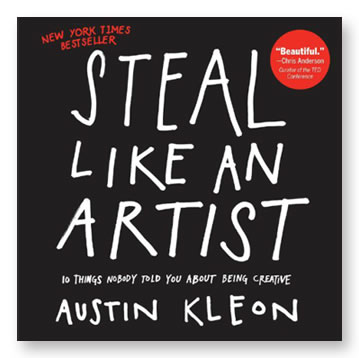
Steal Like an Artist
by Austin Kleon
At a glance, Austin's book may look simple with hand-scrawled chapter titles that say things like "Write the book you want to read" and "Be boring." Don't let looks deceive you, this book has some complex concepts in it. Austin is adept at breaking them down into short, easy to digest chapters with photos and quotes interspersed. My favorite chapter might be "Creativity is subtraction." I don't think it gets any more straight forward or concise than this.
Putting your work out into the world
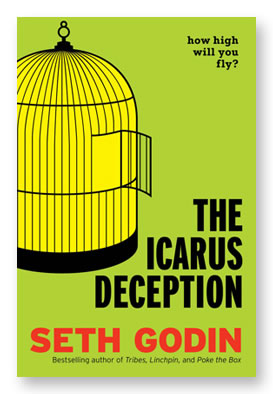
The Icarus Deception
by Seth Godin
This is a collection of blog posts from the prolific Seth Godin. After reading this book, you'll be all out of excuses for why you can't write your story, make artwork and put them out into the world.
Are you still here? You've got a lot of reading to do...

Friday, May 31st, 2013
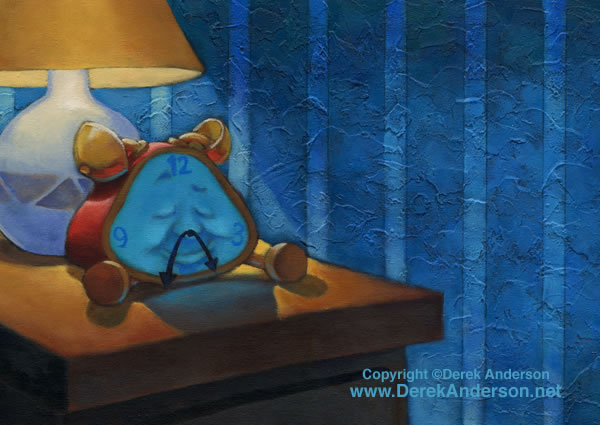
An early painting from before I was published
Acrylic and molding paste on canvas from 1998 or 1999
What every aspiring
author and illustrator
should know
about getting published
~ Part Four ~
Dealing with rejection
Rejection can ruin you if you let it. Imagine going to the mailbox and, on an almost daily basis, finding a letter telling you that your work isn't good enough. How would that make you feel? Whether you're an aspiring author or artist, that's what you have to face when you set out to get published.
"Your work isn't right for us at this time."
"Unfortunately, it does not suit our present publishing program."
"We have now had a chance to consider your work, and we regret to say that it is not right for us."
"Thanks for the look, but I don't think your style is right for us."
These are actual quotes from rejection letters I received. And they weren't just coming from big publishers. There were small publishers and agents jumping on the "no" bandwagon as well. For a number of years, it seemed like my work wasn't right for anyone. As you can probably guess, those weren't fun years. I was working full time and spending most of my spare time writing stories, painting pictures and preparing packages to send off to people that didn't want them.
While it can be terribly disappointing to be rejected on a regular basis, you have to put it into perspective. If you take another look, you'll notice that not one of those sentences was about me, personally. Their judgments are referring to pictures and stories I'd made. But if you look even deeper, you'll notice their judgments aren't really even about my work. They're all about the publisher's needs. It's what they're looking for in stories and pictures. That's it. I made something that they didn't see a need for. That isn't much of a consolation when you've poured your heart and soul into a story or picture. It's still rejection.
When I began sending my work out, I would get rejection letters occasionally. But with time, I became more prolific and ambitious with my mailings, sending samples of my work to twenty or more publishing houses at a time. The rejection letters turned from a trickle to a steady stream. I was always armed with high hopes when I sent my work off, but as those letters came back, they could ruin my morning, my day and sometimes my week. And then something exciting happened. I'd submitted a manuscript with some sample paintings to a large New York publisher and they were interested. They asked if I would revise the story and they made some suggestions. This was it. My dream was about to come true. Every unfinished story and bad picture I'd ever made had suddenly become worth it. I took my time, carefully revising the story and when I was sure it was right, I resubmitted it and crossed my fingers. I didn't hear anything for more than a month. One Friday afternoon I went out to the mailbox and found a letter from the editor. I almost couldn't open it, but I had to know. I tore open the envelope and read her words...
"After much consideration, I regret to inform you that this book is not a right fit for our list."
I was heartbroken. I couldn't keep doing this, not this way. I knew I had to change something or I wouldn't be able to hold on.
Psychology is a powerful thing. We all have the power to control how we look at the world. You can put a positive or negative spin on almost anything. It's about your vantage point. What you're looking at doesn't have to change, you're simply altering the lens you're looking through. And that's what I changed. I wasn't going to give up on my pursuit of being a published children's book author and artist. And I wasn't going to change the kind of work I was doing. I didn't want to be anybody else. I wanted to do my work, to get into this business on my own strengths and abilities. So I started collecting rejection letters. Yes, collecting them. It may sound like a strange approach, but here's the thing- I couldn't control what the publishers wanted. I could, however, control how I looked at their rejections. I would keep writing stories, making pictures and sending them off to publishers and amass the largest collection of rejection letters that I possibly could. That was a huge turning point for me. From that day on, a rejection letter never got to me again. It was just another trophy to add to my collection. And in the meantime, it gave me the time I needed to let my stories and paintings mature.
I still have every one of those rejection letters. An author once told me that she thought it was sadistic to keep them. I don't see it that way. I earned every letter in that file. Whether you see them as scars or trophies, they're evidence that I traveled the road to publication. I took on the obstacles, avoided the pot holes and parking places and made my own mistakes. It wasn't an easy trip, there are definitely some things I would do differently, but I ended up exactly where I wanted to be. And the best part is, the trip down that road wasn't even the journey. It was just the preparation. It was packing my bags for the trip of a lifetime. I just finished my twenty-first book and the journey, for me, is just beginning.

Friday, May 24th, 2013

What every aspiring
author and illustrator
should know
about getting published
~ Part Three ~
Make yourself a student
I rediscovered children's books during my senior year in college. My mother, who was a grade school teacher at the time, had traveled to the International Reading Association Convention in Florida and returned with stacks of new children's picture books. I came home from college one weekend and found the books covering the kitchen table. I hadn't taken a look at a children's book since I was a kid. They were absolutely amazing. The stories were engaging and well written and so much fun. And the pictures were works of art. There were no limitations to what a storyteller with a big imagination could do. That was when I knew I wanted to make children's books.
There's usually a revelation of some kind for people who want to do this. But writing engaging stories and creating strong works of art is only the beginning of the journey. Getting the work in front of the people that decide what gets published is another.
Let's say you're a writer or artist and you're making things- great, interesting and original things! You've practiced, made mistakes and discovered your strengths and weaknesses. You've revised your work and you have something special you'd love to show a publisher. Now what? You don't have an uncle that works in publishing, you don't have any friends that are authors or illustrators and you don't have the first idea about where to go or what to do.
You can't get into a business that you don't know anything about. If you wrote a script for a movie, you wouldn't send it to a movie star and ask them to star in your movie. The publishing world is no different. If you've written a story, you don't send it to a children's book artist and ask them to illustrate your book. It's not a book. Not yet. Publishers produce books. Editors work for publishers. And editors are the ones that decide what will be published.
That all sounds easy enough, doesn't it? Just pop your story into an envelope and send it off to an editor. It's a bit more complicated than that. You can't pick a random children's book editor and send him or her your work. Editors aren't generic, faceless robots that are open to any story for any age and in any style. They're people with highly individualized sensibilities, personal likes and dislikes, and tastes just like everybody else. A children's book creator's goal is to connect with an editor that likes what you do, shares your sensibilities and will challenge you and push you to do your very best work. Your picture book story could be clever and original, but if you send it to an editor that only edits young adult novels or middle grade chapter books, you're wasting your time.
You have to do your homework. That's why it's so important to get educated about the business you want to get into. Locating the right editor at the right house is only the first step of many. What happens when you don't hear from the editor for two months? Or ten? And what happens when you finally get a form letter stating they don't accept "unsolicited manuscripts?" What does that mean? Can you send it to more than one editor at a time? Should you try to find an agent first? There are more questions than I can possibly answer here. And the answers can be different for every author and artist depending on who you are, what you've published and what you want for your career. You have to take each question as it comes, evaluate it, consult someone if you have to and do what's right for you. Some authors and artists prefer agents. I have an attorney. Some work with only one editor at one publishing house. Some have multiple editors at multiple publishing houses. You're competing with thousands (or even tens of thousands) of writers and artists that want to be published. Those that know their stuff are going to have a better chance at beating the odds.
Here are three steps I strongly recommend taking:
1. Do your research
That means read, read, read! Not just books about getting published. Read what's being published in the genre you want to get into. Become an expert on publishers, the imprints and what they specialize in. Know what the benefits are of publishing with a smaller house over a larger one and vice versa. You have to spend time in bookstores and libraries buying, checking out and reading books. Study what the artists and writers are doing. Not so you can copy them, it's so you can be aware of other perspectives, sensibilities and approaches. Reading good writing doesn't take anything away from your own work. It adds to your depth. But not everyone is interested in playing in the deep end of the pool.
Early in my career, I was signing books at a children's book conference and had an opportunity to hear a couple of the speakers. I will never forget one author. He was on stage, speaking about his chapter book for children which was, to my knowledge, the only book he's ever published. Someone in the audience asked him what some of the children's books were that he enjoyed reading. He leered at the woman who asked the question and said, "I don't read children's books because I'm not a child." You could feel the collective air let out of the room. That's certainly an interesting point of view. I don't know how anyone can call himself a writer and not be aware of what anyone else is doing in the arena. Writers are readers. We have a love of words and stories. I read everything from picture books, early readers and middle grade novels to graphic novels, YA, and both fiction and nonfiction for adults (I'm a little obsessed with biographies of artists and writers). Literature is just that, literature. It doesn't matter whether it's intended for a six year old, a sixteen year old or a sixty year old. If it's well written and interesting, I enjoy it.
Your research, however, should go beyond content. You should recognize what makes a good cover. You should know that most children's picture books are thirty-two pages (or a multiple of eight) and why. You should know how printed endpapers can change the page count of a book. You have to make children's books your obsession. That's what I did. Before I was published, I made it my business to know what authors and illustrators were doing, who they were publishing with and why that publisher may or may not be a good place to send my work. And the resources now are much more plentiful than when I was trying to get published.
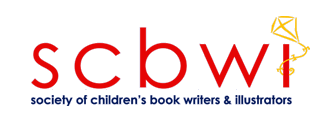
2. Join SCBWI
SCBWI stands for Society of Children's Book Writers and Illustrators. It's an international organization for both aspiring and published authors and illustrators. They have chapters in every state in the U.S. and a number of them abroad, as well. They hold both local and national conferences where they invite editors, art directors, authors, artists and agents to speak about the nuts and bolts of the children's publishing business. I've spoken at their conferences. If you're interested in getting published, I would urge you to attend a local conference in a city near you. It's a great way to meet people in the business, find answers to your questions and connect with others that are trying to do the same thing you are.
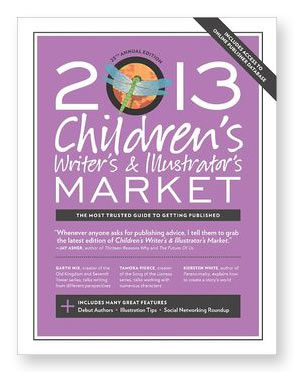
3. Buy a copy of Children's Writer's and Illustrator's Market
It's the go-to "how to" on getting published and can be found in the reference section of most large bookstores. It's a great resource full of nearly every active publisher, their imprints, names of acquiring editors, addresses and even the kinds of books they're looking for. You'll also find agent listings, magazine contacts and other markets for your artwork and stories. It's updated every year, so make sure you buy the most recent edition.
I've certainly loaded a lot on your plate. Before you start in with excuses for why you don't have time to write, draw, do research, read, join organizations, go to conferences and learn about the publishing business, consider how important this dream is to you. You have to make sacrifices for the things you want. We all do. There isn't enough time, money or room in our comfort zones to have everything we want and stay the way we are. Sometimes the obstacles that exist in our minds are far greater than the obstacles that exist in the world. Just remember there are two ways to look at anything. You can look at it as a burden, or you can look at it as an adventure. It's all a matter of perspective.
Coming next week: Part Four: Dealing with rejection
You can visit SCBWI's website HERE.
You can buy a copy of Children's Writer's & Illustrator's Market HERE.

Friday, May 17th, 2013
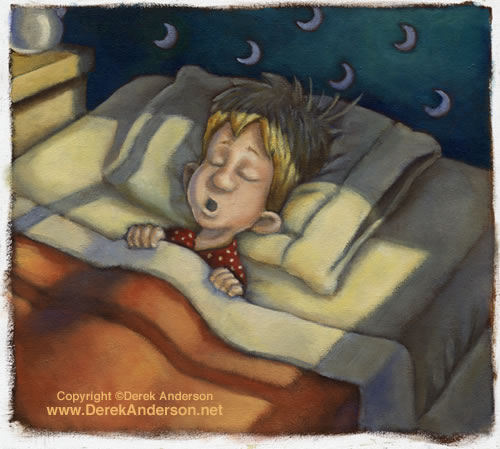
An early painting from before I was published
Acrylic on canvas from 1998 or 1999
What every aspiring
author and illustrator
should know
about getting published
~ Part Two ~
Do the work
I landed my first job at the ripe old age of eight. That's right, eight years old. It was delivering papers. I know that sounds young, but my parents didn't give us allowances so my brothers and I learned very early on that we had to work for what we wanted. The paper route was only once a week. It was an advertiser so the papers were thick and heavy and I had around a hundred houses on my route. Each Wednesday, I loaded the papers into my wagon and walked up and down block after block distributing them. I never knew what I would encounter on the route. There were loose dogs, busy streets to cross, thunderstorms in the summer and blizzards in the winter. I couldn't let any of those obstacles get in the way of what I needed to do. I had to choose one house on one street and get started. It seems simple enough doesn't it? That's how you conquer anything.
For some reason, people don't treat writing stories and creating artwork the same way. Believe it or not, there are people that say they have ideas and they want to be published, but they never actually make anything.
If someone has an idea for an invention that could change the world, but they never make it, guess what's going to happen? Nothing. And I don't care how good your idea for a book or picture is, if you don't take the time to write it or draw it, and give it a chance to become something, it won't become anything.
There's a not-so-secret ingredient to writing and illustrating books... you have to do the work. Having a great idea for a story isn't enough. Publishers don't buy ideas. They need to see real stories from writers and real pictures from artists. You have to put your ideas to the test. And when you do you're going to discover one of those truths about creating that's also a truth about life:
Things hardly ever, almost never go as planned.
I can understand that people are afraid. It's a scary thing to face your fears and actually do the thing you dream of. It's safer to not do it. Some are happy with that perfect, ideal image of what would happen if they took a step toward their dream. They know they'd be wildly successful. So let's ride that dream train together for a second. Wouldn't it be wonderful to create something so amazing that the second it arrives on a publisher's desk, they have to have it and frantically call you offering a book contract and a giant advance. When your book is published, it's translated into foreign languages and becomes a sensation around the world. Newspapers and magazines fight with one another, scrambling to be the first to interview you. Piers Morgan, Charlie Rose and Ellen DeGeneres want to talk to you about how great you are and, of course, Matt Lauer calls about an appearance on the Today show. The world is watching, in awe, as you ride the bestseller lists to the top, graciously bowing before the endless applause and accolades. Hey, snap out of it. It's a nice dream... but it has nothing to do with the act of creating anything. That one's all about a need for recognition. Forget fame, applause and accolades. The writers and artists that get published and succeed in this business do it because we have to create. We need to make interesting characters and worlds that challenge us and push us beyond our abilities.
Creating stories and pictures is hard. It takes a lot of practice. You'll quickly find that stories often go nowhere, and artwork rarely turns out the way you thought it would. That's where it begins. You'll study it and ponder it and ask yourself what went wrong. You'll discover why it didn't work and how to make it better and the most amazing thing will happen while you do. You'll grow. That's what makes creating so exciting. There are big surprises. You'll find a perfect direction for your story that you never expected. Or a new character will come wandering into your artwork that you didn't invite.
The work begins for both writers and artists with a simple toolbox. I'm not talking about monkey wrenches and power drills here. It's your own, personal set of creative devices. It begins with paper, pens, laptops and sketchbooks. But the rest of your creative toolbox is stocked with skills that are developed through the act of making things.
For writers- you have to find your own voice. And just what does that mean? It means you have a unique way of telling a story. Find it. It's your palette. It's how you create characters and make them sympathetic. It's how you engage the reader and take them on a journey. It involves language, dialogue and how you handle tension. You don't learn these things by writing one story and saying, "Bring on the publishers." You need to study people and discover what motivates them to behave the way they do. You need to listen to how people speak. You need to learn to describe your invented world with such intoxicating clarity that your reader can see what you see. But you have to do it with as few words as possible. The job of the author isn't to wow the reader with your language, it's to make the words disappear. A story should pull a reader in so deeply, they forget they're reading.
A writer should know the difference between first person, third person and third person omniscient narratives and what the strengths and limitations are of each one. If you don't, you need to take a fiction writing class before you show your stories to anyone. Those are the very basic tools of a writer. It isn't necessary to know how to spot a dangling participle to tell a good story. But you do need to have a strong enough grasp of English to edit your work. A writer should never, under any circumstances, submit a first draft of anything.
For artists- you have to find your voice, too. Your visual voice. It's what makes the look and feel of your work unique and different from what everyone else is doing. It isn't just about brushes, painting surface and palette. You have to learn what makes a good, strong composition. You have to create characters and give them personalities beyond what exists in a text. You have to be able to render them from different angles, with different expressions and gestures, and keep the palette, the world and the details relatively the same from one picture to the next. You have to learn how to carry a narrative and make actions clear at a glance. And pacing is a crucial part of every children's picture book. You're telling a story visually and you have to keep your reader turning the pages in anticipation. It may look easy. In fact, I'm sure it does. But anyone that's ever said it's easy to make a book has never made one. It takes a lot of effort to make something appear effortless.
Aspiring writers and book artists need to face hard truths. You need to ask yourself if you're really ready. What do you have trouble writing or drawing? What are your weaknesses? Once you go pro, you don't get the luxury of waiting for inspiration to come. There are deadlines to meet. You need to have strong instincts and be ready to create without hesitation. Paying your dues isn't about passing time, it's about developing all aspects of your creative abilities. Your job is to make your work come to life.
The road to publication isn't easy. It's long, bumpy and littered with potholes, obstacles and a whole lot of parking places. No one knows what's going to happen when we set out on it. But that's also true of life. Whether you're an eight year old with a paper route or a grownup with a full time job and a dream, sometimes you just have to choose a place to begin and get started.

Friday, May 10th, 2013
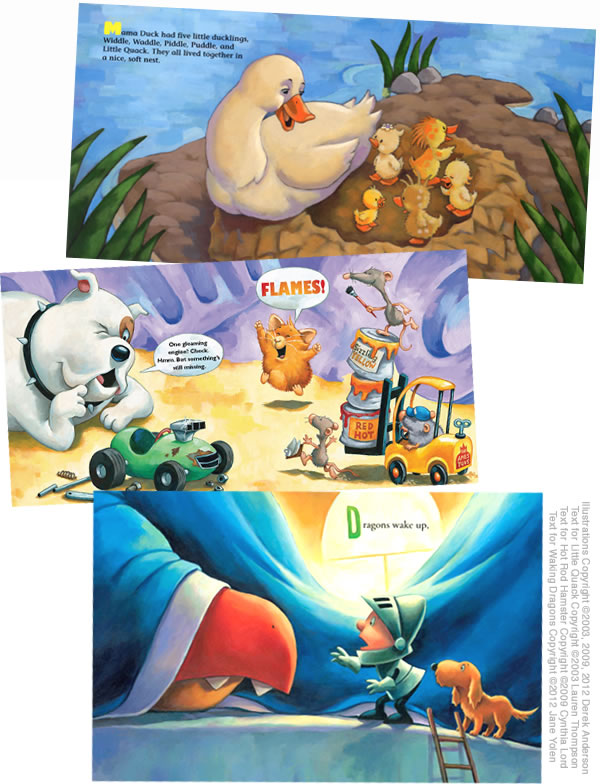
What every aspiring
author and illustrator
should know
about getting published
~ Part One ~
Making a living as an artist and writer goes against nearly everything we're taught when we're growing up. The conventional path is to find a pursuit that interests you, go to college for it and hopefully find a full time job doing exactly that. It doesn't always work that way if you're interested in a pursuit that's unconventional.
When I was in college at Iowa State University, I studied Fine Art with an emphasis in drawing, painting and printmaking and I took every fiction writing class the university offered. Upon telling that to new acquaintances, they'd always ask the same thing, "But what are you going to do when you get out of school?" People just don't go on to become artists and authors. Or at least most don't. And if you don't believe you can make a living as an artist, why try?
I can tell you one thing for certain... if you don't try, it will never happen.
Writing and illustrating books is one of those unconventional jobs that no one quite knows how to get into. There isn't a building where you go apply for this job. This isn't a forty hour-a-week position, you don't get paid every two weeks and no one seems to care where you went to school or for what. And books cost a lot of money to make, so publishers are careful about hiring people that have never made one before. It's all a bit confusing for someone trying to break into this business.
For some reason, there's a notion out there that published children's book artists have the keys to the back door of the publishing business. That we are the answer to their publishing dreams. You would not believe how many aspiring authors email me every month asking me to illustrate their stories. That's simply not how this business works. I always write back with a short list of steps they should take to learn about the business of children's books and how it works. If they're serious, they'll take those steps and learn the proper etiquette for submitting their work to publishers. My guess is most of them get discouraged and quit. It's hard work to get published. It takes more than an ability to write good stories and draw and paint good pictures. That's only the beginning.
Getting published is like chasing any dream. There isn't a magic pill or a short cut. You can seek out people that have done it and ask their advice. You might stumble onto an insider's tip or a secret method someone else used. But ultimately, they can't do it for you. Eventually, you have to decide that this is something that's important to you and begin to work at it. Getting published can take months or, more likely, years. You're going to get rejected. Probably a lot. You're going to get criticized. Probably a lot. You're going to work for long stretches with what may seem like little or no results. There will be friends and people you meet that will ask you why you're wasting your time. And, of course, there's no guarantee that your dream will ever come true. Discouraging? It can be. It all depends on how you look at it. But here's the good news- if you're passionate, driven to create and willing to keep trying new things, it could happen.
Years ago, before I was published, I was having a conversation with a friend. "What will you do," he asked, "if this dream doesn't come true? Because it might not, you know." I was a little surprised by the question. But I realized, at that moment, that he didn't really know me. He had no idea what I was truly capable of. How could he? A point of view is exactly that- a point of view. People see things from their own limited set of experiences. He couldn't see the world from the same vantage point I did. This dream wasn't really a dream anymore. It had become a goal that I was absolutely committed to. I would never give up. Ever. I literally couldn't be broken. If it was possible for anyone to be published in a lifetime, it would happen to me. It didn't matter how long it would take, how many pictures I had to paint or how many stories I had to write. I was in it for the long haul. It took three more years after that conversation before I got my first publishing deal. Those weren't easy years, but it was worth the wait.
Over the next weeks, I'll tell you about the road to publication and how you can set out on it. If you're not interested in getting published, come along anyway. I have some fun stories to tell. I'll tell you how I learned about the business of children's publishing, how I kept from drowning in the endless stream of rejection letters, constant criticism and one failure after another.
The rest will be up to you.
